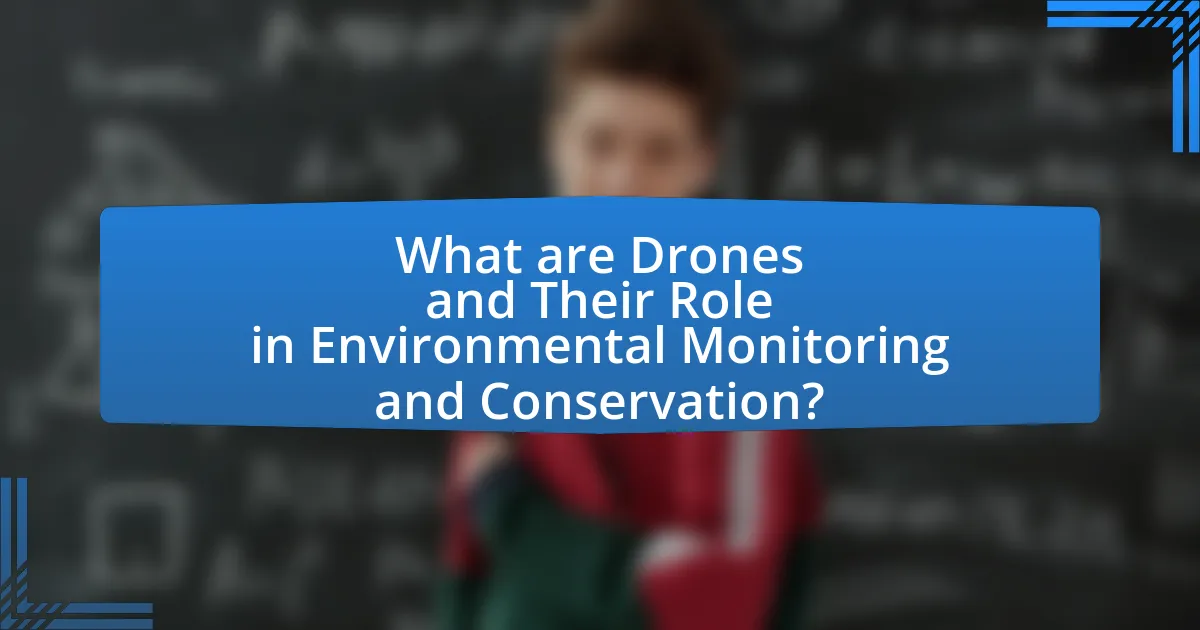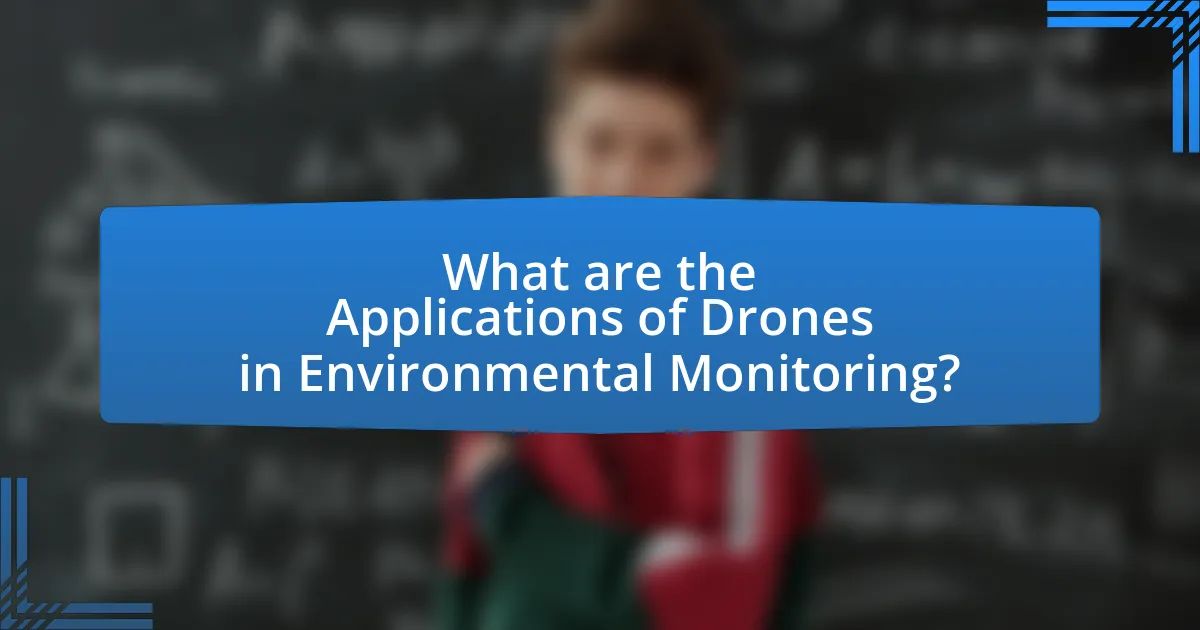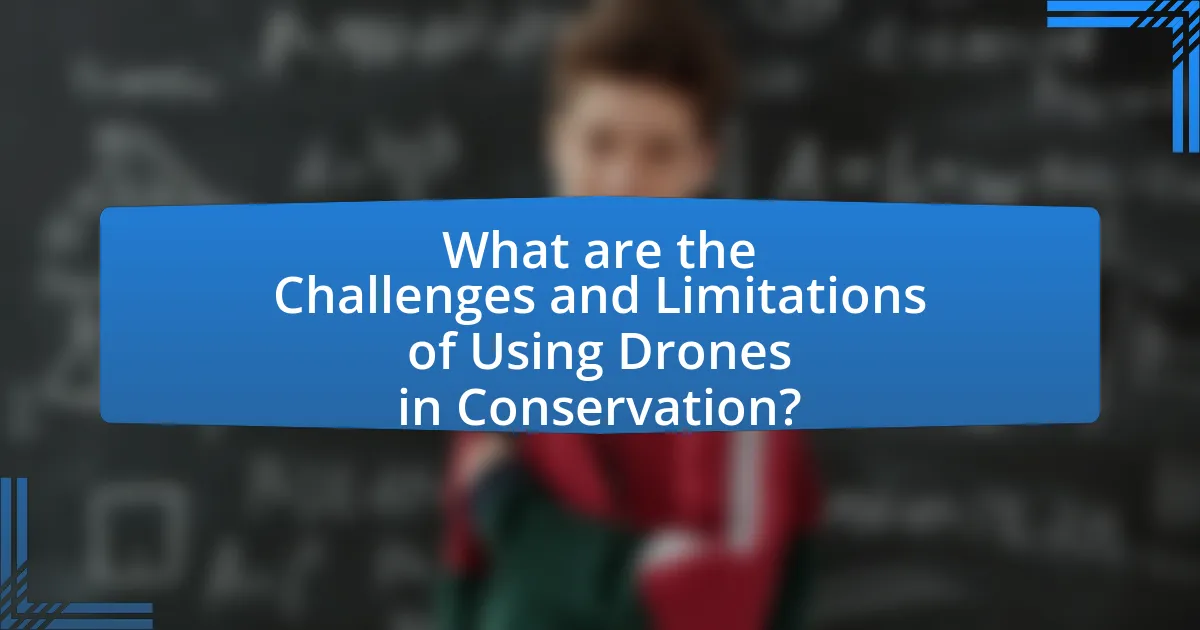Drones, or unmanned aerial vehicles, are increasingly utilized in environmental monitoring and conservation due to their ability to collect high-resolution aerial data efficiently. This article explores the various roles drones play in assessing ecosystems, tracking wildlife populations, and monitoring habitat conditions, highlighting their effectiveness in mapping vegetation, monitoring deforestation, and assessing coral reef health. Key technologies integrated into drones, such as high-resolution cameras and thermal imaging sensors, enhance their data collection capabilities, while challenges like regulatory restrictions and technical limitations are also addressed. The article emphasizes the advantages of drones over traditional monitoring methods, including improved data accuracy and the ability to access hard-to-reach areas, ultimately showcasing their significance in contemporary conservation efforts.

What are Drones and Their Role in Environmental Monitoring and Conservation?
Drones are unmanned aerial vehicles equipped with sensors and cameras that play a crucial role in environmental monitoring and conservation. They enable the collection of high-resolution aerial imagery and data, facilitating the assessment of ecosystems, wildlife populations, and habitat conditions. For instance, studies have shown that drones can monitor deforestation rates, track animal movements, and assess the health of coral reefs, providing valuable insights that inform conservation strategies. The use of drones in these contexts has been validated by research, such as a 2020 study published in the journal “Remote Sensing,” which demonstrated their effectiveness in mapping vegetation and monitoring biodiversity in various ecosystems.
How do drones function in environmental monitoring?
Drones function in environmental monitoring by collecting high-resolution aerial data that enables the assessment of ecological conditions. Equipped with sensors and cameras, drones can capture images and gather information on vegetation health, wildlife populations, and land use changes. For instance, studies have shown that drones can monitor deforestation rates and track the health of coral reefs, providing critical data for conservation efforts. Their ability to cover large areas quickly and access hard-to-reach locations enhances the efficiency and accuracy of environmental assessments, making them a valuable tool in ecological research and management.
What technologies are integrated into drones for monitoring purposes?
Drones for monitoring purposes integrate several key technologies, including high-resolution cameras, LiDAR (Light Detection and Ranging), thermal imaging sensors, GPS (Global Positioning System), and data analytics software. High-resolution cameras capture detailed images for visual assessments, while LiDAR provides precise topographical data, enabling the analysis of vegetation and terrain. Thermal imaging sensors detect temperature variations, useful for identifying wildlife and assessing environmental conditions. GPS technology ensures accurate positioning and navigation, facilitating systematic data collection. Data analytics software processes the collected information, allowing for actionable insights in environmental monitoring and conservation efforts. These technologies collectively enhance the effectiveness of drones in monitoring ecosystems, wildlife, and environmental changes.
How do drones collect and transmit environmental data?
Drones collect and transmit environmental data using various sensors and communication technologies. Equipped with instruments such as multispectral cameras, LiDAR, and thermal sensors, drones capture high-resolution images and measurements of environmental parameters like vegetation health, temperature, and topography. The data collected is processed onboard or transmitted in real-time to ground stations via wireless communication systems, such as radio frequency or cellular networks. This capability allows for timely analysis and decision-making in environmental monitoring and conservation efforts, as evidenced by studies demonstrating the effectiveness of drone technology in mapping ecosystems and assessing wildlife habitats.
Why are drones becoming essential tools in conservation efforts?
Drones are becoming essential tools in conservation efforts due to their ability to collect high-resolution data over large and inaccessible areas efficiently. These unmanned aerial vehicles can monitor wildlife populations, track habitat changes, and assess environmental conditions without disturbing ecosystems. For instance, a study published in the journal “Conservation Biology” demonstrated that drones could effectively survey elephant populations in Africa, providing accurate counts and behavioral observations that traditional methods could not achieve. This capability enhances conservation strategies by enabling timely interventions and informed decision-making based on real-time data.
What advantages do drones offer over traditional monitoring methods?
Drones offer significant advantages over traditional monitoring methods, primarily through enhanced data collection efficiency and accessibility. Unlike ground-based methods, drones can cover large areas quickly, capturing high-resolution imagery and data in real-time. For instance, a study by Anderson and Gaston (2013) demonstrated that drones could survey 1,000 acres in a fraction of the time it would take traditional methods, which often require extensive manpower and time. Additionally, drones can access hard-to-reach or hazardous areas, reducing risks to human monitors while providing comprehensive environmental insights. This capability is particularly beneficial in conservation efforts, where timely and accurate data is crucial for decision-making.
How do drones enhance data accuracy and efficiency in conservation?
Drones enhance data accuracy and efficiency in conservation by providing high-resolution aerial imagery and real-time data collection. These unmanned aerial vehicles can cover large areas quickly, capturing detailed information about wildlife populations, habitat conditions, and environmental changes. For instance, a study published in the journal “Remote Sensing” demonstrated that drones could achieve up to 90% accuracy in mapping vegetation types compared to traditional ground surveys, which are often time-consuming and labor-intensive. This capability allows conservationists to make informed decisions based on precise data, ultimately improving the effectiveness of conservation strategies.

What are the Applications of Drones in Environmental Monitoring?
Drones are utilized in environmental monitoring for various applications, including habitat mapping, wildlife tracking, and pollution assessment. These unmanned aerial vehicles provide high-resolution imagery and data collection capabilities, enabling researchers to monitor ecosystems efficiently. For instance, drones can capture detailed aerial photographs to assess vegetation health and biodiversity, which is crucial for conservation efforts. Additionally, they are employed to track animal movements and populations, offering insights into species behavior and habitat use. Furthermore, drones facilitate the detection of pollutants in water bodies and air quality monitoring, contributing to environmental protection initiatives. The effectiveness of drones in these applications is supported by studies demonstrating their ability to cover large areas quickly and gather data that would be difficult to obtain through traditional methods.
How are drones used in wildlife tracking and research?
Drones are utilized in wildlife tracking and research primarily for monitoring animal populations and their habitats. These unmanned aerial vehicles (UAVs) provide high-resolution imagery and real-time data collection, enabling researchers to observe wildlife behavior, migration patterns, and habitat changes without disturbing the animals. For instance, studies have shown that drones can cover large areas quickly, allowing for efficient tracking of species such as elephants and whales, which are often difficult to monitor from the ground. Additionally, drones equipped with thermal imaging can detect heat signatures, making it easier to locate animals in dense vegetation or during nighttime. This technology enhances the accuracy of wildlife research and contributes to effective conservation strategies.
What specific species benefit from drone monitoring?
Bird species, particularly those that are endangered or have specific habitat requirements, benefit significantly from drone monitoring. Drones provide a non-intrusive method to track populations, nesting sites, and migration patterns, which is crucial for conservation efforts. For instance, studies have shown that drones can effectively monitor the nesting success of seabirds like the puffin and the albatross, allowing researchers to gather data without disturbing the birds. Additionally, large mammals such as elephants and rhinos are monitored using drones to prevent poaching and to assess their habitat use. This technology enhances the ability to collect accurate data on these species, thereby supporting targeted conservation strategies.
How do drones assist in habitat mapping and assessment?
Drones assist in habitat mapping and assessment by providing high-resolution aerial imagery and data collection capabilities. These unmanned aerial vehicles can cover large areas quickly, capturing detailed information about vegetation types, land use, and wildlife distribution. For instance, studies have shown that drones equipped with multispectral cameras can identify plant species and assess their health, enabling ecologists to monitor changes in habitats over time. Additionally, drones facilitate the collection of data in hard-to-reach areas, improving the accuracy of habitat assessments and allowing for more effective conservation strategies.
What role do drones play in assessing environmental changes?
Drones play a crucial role in assessing environmental changes by providing high-resolution aerial imagery and data collection capabilities. These unmanned aerial vehicles (UAVs) enable researchers to monitor ecosystems, track wildlife populations, and assess land use changes with precision. For instance, studies have shown that drones can capture detailed images for vegetation analysis, allowing for the detection of changes in plant health and biodiversity over time. Additionally, drones facilitate the monitoring of deforestation rates, wetland degradation, and the impacts of climate change, offering timely data that supports conservation efforts and policy-making.
How can drones monitor deforestation and land use changes?
Drones can monitor deforestation and land use changes by capturing high-resolution aerial imagery and utilizing remote sensing technology. These drones are equipped with cameras and sensors that collect data on vegetation cover, land topography, and changes over time. For instance, studies have shown that drones can provide detailed maps of forest cover, enabling the detection of illegal logging activities and land conversion for agriculture. Research published in the journal “Remote Sensing” demonstrates that drone imagery can achieve an accuracy of over 90% in identifying land use changes, making them a reliable tool for environmental monitoring.
What impact do drones have on tracking climate change effects?
Drones significantly enhance the tracking of climate change effects by providing high-resolution data and real-time monitoring capabilities. They can capture detailed imagery and collect environmental data over large areas, which is crucial for assessing changes in ecosystems, ice melt, deforestation, and other climate-related phenomena. For instance, a study published in the journal “Remote Sensing” demonstrated that drones can monitor vegetation health and carbon storage in forests, offering insights into how these ecosystems respond to climate change. This capability allows researchers to analyze trends and make informed predictions about future climate scenarios, thereby improving our understanding of climate dynamics.

What are the Challenges and Limitations of Using Drones in Conservation?
The challenges and limitations of using drones in conservation include regulatory restrictions, technical limitations, and data interpretation issues. Regulatory restrictions often hinder drone operations due to airspace regulations and permits required for flight, which can vary significantly by region. Technical limitations arise from battery life, payload capacity, and the need for advanced sensors, which can restrict the types of data collected and the duration of flights. Additionally, data interpretation issues stem from the complexity of analyzing the vast amounts of data collected, requiring specialized skills and software to derive meaningful insights. These factors collectively impact the effectiveness and efficiency of drone use in conservation efforts.
What regulatory issues affect drone usage in environmental monitoring?
Regulatory issues affecting drone usage in environmental monitoring primarily include airspace restrictions, privacy laws, and environmental protection regulations. Airspace restrictions are enforced by aviation authorities, such as the Federal Aviation Administration (FAA) in the United States, which mandates specific flight altitudes and no-fly zones, particularly near wildlife reserves and populated areas. Privacy laws, including the General Data Protection Regulation (GDPR) in Europe, impose limitations on data collection and surveillance, requiring operators to ensure that drone usage does not infringe on individuals’ privacy rights. Additionally, environmental protection regulations, such as the National Environmental Policy Act (NEPA) in the U.S., necessitate assessments to evaluate the potential environmental impact of drone operations, particularly in sensitive ecosystems. These regulatory frameworks collectively shape the operational landscape for drones in environmental monitoring, ensuring compliance with safety, privacy, and ecological standards.
How do privacy concerns impact drone operations in conservation?
Privacy concerns significantly impact drone operations in conservation by limiting the areas where drones can be deployed and the types of data they can collect. Regulations often require that drone operators obtain consent from individuals in the vicinity, which can hinder monitoring efforts in remote or populated areas. For instance, in the United States, the Federal Aviation Administration (FAA) has established guidelines that restrict drone flights over private property without permission, thereby complicating conservation efforts that rely on aerial surveillance for wildlife monitoring and habitat assessment. These privacy regulations can lead to reduced data collection efficiency and may necessitate the use of alternative methods that are less effective or more costly.
What are the limitations of drone technology in harsh environments?
Drone technology faces significant limitations in harsh environments, primarily due to adverse weather conditions, battery performance, and sensor reliability. For instance, extreme temperatures can affect battery life, reducing flight time and operational efficiency; studies show that lithium-ion batteries can lose up to 20% of their capacity in cold conditions. Additionally, high winds and precipitation can hinder stability and control, leading to potential crashes or loss of data. Furthermore, sensors may struggle to function optimally in conditions such as heavy rain or snow, which can obscure visibility and affect data collection accuracy. These factors collectively restrict the effectiveness of drones in conducting environmental monitoring and conservation efforts in challenging settings.
How can these challenges be addressed to improve drone effectiveness?
To improve drone effectiveness in environmental monitoring and conservation, challenges can be addressed through enhanced technology integration, regulatory compliance, and training programs. Implementing advanced sensors and AI algorithms increases data accuracy and processing speed, allowing for real-time analysis of environmental conditions. For instance, drones equipped with multispectral cameras can capture detailed imagery for vegetation health assessment, improving conservation efforts. Additionally, adhering to regulations ensures safe operation and minimizes disruptions to wildlife, as demonstrated by studies showing reduced animal stress when drones are operated at appropriate altitudes. Finally, comprehensive training for operators enhances piloting skills and data interpretation, leading to more effective deployment in conservation projects.
What best practices can enhance drone operations in conservation efforts?
Best practices that can enhance drone operations in conservation efforts include thorough pre-flight planning, adherence to regulatory guidelines, and the use of advanced imaging technologies. Pre-flight planning ensures that drones are deployed effectively, optimizing flight paths and minimizing risks to wildlife. Compliance with regulations, such as those set by aviation authorities, is crucial for safe operations and to avoid legal issues. Utilizing advanced imaging technologies, such as multispectral and thermal cameras, allows for more accurate data collection, enabling better monitoring of ecosystems and wildlife populations. Studies have shown that drones equipped with these technologies can significantly improve data accuracy and reduce the time needed for surveys, thereby enhancing conservation outcomes.
What are the Future Trends in Drone Technology for Environmental Monitoring?
Future trends in drone technology for environmental monitoring include increased automation, enhanced data collection capabilities, and improved integration with artificial intelligence. Automation will allow drones to conduct routine monitoring tasks with minimal human intervention, increasing efficiency and reducing operational costs. Enhanced data collection capabilities will involve the use of advanced sensors, such as multispectral and thermal imaging, enabling more precise assessments of environmental conditions. Furthermore, the integration of artificial intelligence will facilitate real-time data analysis, allowing for quicker decision-making and more effective responses to environmental changes. These trends are supported by ongoing advancements in drone technology and growing demand for accurate environmental monitoring solutions.
How is AI being integrated into drone technology for better monitoring?
AI is being integrated into drone technology to enhance monitoring capabilities through advanced data analysis and real-time decision-making. Drones equipped with AI algorithms can process vast amounts of data collected from sensors and cameras, enabling them to identify patterns, detect anomalies, and classify objects autonomously. For instance, AI-driven drones are utilized in environmental monitoring to track wildlife populations, assess habitat conditions, and detect illegal activities such as poaching or deforestation. Research indicates that AI can improve the accuracy of monitoring efforts by up to 90%, significantly increasing the efficiency of conservation initiatives.
What innovations are expected to enhance drone capabilities in conservation?
Innovations expected to enhance drone capabilities in conservation include advanced sensor technology, artificial intelligence (AI) integration, and improved battery life. Advanced sensors, such as multispectral and thermal imaging cameras, allow drones to collect detailed data on vegetation health, wildlife populations, and habitat conditions. AI integration enables real-time data analysis, facilitating quicker decision-making for conservation efforts. Additionally, advancements in battery technology are extending flight times, allowing drones to cover larger areas and gather more comprehensive data. These innovations collectively improve the efficiency and effectiveness of conservation monitoring and management.
What practical tips can be applied for effective drone use in environmental monitoring?
Effective drone use in environmental monitoring can be achieved by ensuring proper planning, utilizing high-resolution sensors, and adhering to regulatory guidelines. Proper planning involves selecting optimal flight paths and times to capture relevant data, which enhances data quality and reduces operational risks. High-resolution sensors, such as multispectral and thermal cameras, provide detailed insights into environmental conditions, enabling precise assessments of vegetation health, water quality, and wildlife populations. Adhering to regulatory guidelines ensures compliance with local laws and safety standards, which is crucial for sustainable drone operations. These practices are supported by studies indicating that drones equipped with advanced sensors can significantly improve data collection efficiency and accuracy in environmental monitoring efforts.


